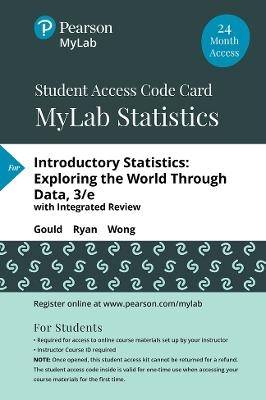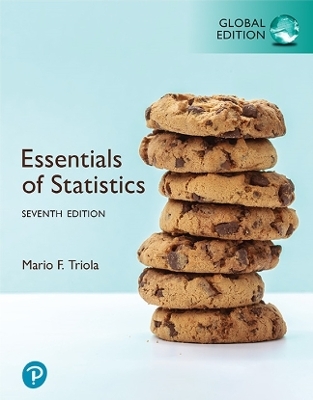
MyLab Statistics with Pearson eText Access Code (24 Months) for Introductory Statistics
Pearson (Hersteller)
978-0-13-519023-4 (ISBN)
- Titel z.Zt. nicht lieferbar
- Versandkostenfrei innerhalb Deutschlands
- Auch auf Rechnung
- Verfügbarkeit in der Filiale vor Ort prüfen
- Artikel merken
This item is an access card for MyLab™ Statistics. This physical access card includes an access code for your MyLab Statistics course. In order to access the online course you will also need a Course ID, provided by your instructor.
This title-specific access card provides access to the Gould/Ryan/Wong, Introductory Statistics: Exploring the World Through Data, 3e accompanying MyLab course ONLY.
0135190231 / 9780135190234 MYLAB STATISTICS WITH PEARSON ETEXT -- STANDALONE ACCESS CARD -- FOR INTRODUCTORY STATISTICS: EXPLORING THE WORLD THROUGH DATA, 3/e
MyLab Statistics is the world’s leading online tutorial, and assessment program designed to help you learn and succeed in your statistics course. MyLab Statistics online courses are created to accompany one of Pearson’s best-selling math textbooks. Every MyLab Statistics course includes a complete, interactive eText. Learn more about MyLab Statistics.
ALERT:
Before you purchase, check with your instructor or review your course syllabus to ensure that you select the correct ISBN.
Used or rental books
If you rent or purchase a used book with an access code, the access code may have been redeemed previously and you may have to purchase a new access code.
Access codes
Access codes that are purchased from sellers other than Pearson carry a higher risk of being either the wrong ISBN or a previously redeemed code. Check with the seller prior to purchase.
About our authors Robert L. Gould (Ph.D., University of California - San Diego) is a leader in the statistics education community. He has served as chair of the AMATYC/ASA joint committee, was co-leader of the Two-Year College Data Science Summit hosted by the American Statistical Association, served as chair of the ASA's Statistics Education Section, and was a co-author of the 2005 Guidelines for Assessment in Instruction on Statistics Education (GAISE) College Report. While serving as the Associate Director of Professional Development for CAUSE (Consortium for the Advancement of Undergraduate Statistics Education), he worked closely with the American Mathematical Association of Two-Year Colleges (AMATYC) to provide traveling workshops and summer institutes in statistics. He was the lead principal investigator of the NSF-funded Mobilize Project, which developed and implemented the first high-school level data science course. For over 20 years, he has served as Vice-Chair of Undergraduate Studies at the UCLA Department of Statistics, and is Director of the UCLA Center for the Teaching of Statistics. In 2012, Rob was elected Fellow of the American Statistical Association. Colleen N. Ryan has taught statistics, chemistry and physics to diverse community college students for decades. She taught at Oxnard College from 1975 to 2006, where she earned the Teacher of the Year Award. Colleen currently teaches statistics part-time at California Lutheran University. She often designs her own lab activities. Her passion is to discover new ways to make statistical theory practical, easy to understand, and sometimes even fun. Colleen earned a B.A. in physics from Wellesley College, an M.A.T. in physics from Harvard University, and an M.A. in chemistry from Wellesley College. Her first exposure to statistics was with Frederick Mosteller at Harvard. In her spare time, she sings with the Oaks Chamber Singers and enjoys time with her family. Rebecca K. Wong has taught mathematics and statistics at West Valley College for more than 20 years. She enjoys designing activities to help students actively explore statistical concepts and encouraging students to apply those concepts to areas of personal interest. Rebecca earned a B.A. in mathematics and psychology from the University of California - Santa Barbara, an M.S.T. in mathematics from Santa Clara University, and an Ed.D. in Educational Leadership from San Francisco State University. She has been recognized for outstanding teaching by the National Institute of Staff and Organizational Development and the California Mathematics Council of Community Colleges. When not teaching, Rebecca is an avid reader and enjoys hiking trails with friends.
1. Introduction to Data
1.1 What Are Data?
1.2 Classifying and Storing Data
1.3 Investigating Data
1.4 Organizing Categorical Data
1.5 Collecting Data to Understand Causality
2. Picturing Variation with Graphs
2.1 Visualizing Variation in Numerical Data
2.2 Summarizing Important Features of a Numerical Distribution
2.3 Visualizing Variation in Categorical Variables
2.4 Summarizing Categorical Distributions
2.5 Interpreting Graphs
3. Numerical Summaries of Center and Variation
3.1 Summaries for Symmetric Distributions
3.2 What's Unusual? The Empirical Rule and z-Scores
3.3 Summaries for Skewed Distributions
3.4 Comparing Measures of Center
3.5 Using Boxplots for Displaying Summaries<
4. Regression Analysis: Exploring Associations between Variables
4.1 Visualizing Variability with a Scatterplot
4.2 Measuring Strength of Association with Correlation
4.3 Modeling Linear Trends
4.4 Evaluating the Linear Model
5. Modeling Variation with Probability
5.1 What Is Randomness?
5.2 Finding Theoretical Probabilities
5.3 Associations in Categorical Variables
5.4 Finding Empirical Probabilities
6. Modeling Rando Events: The Normal and Binomial Models
6.1 Probability Distributions Are Models of Random Experiments
6.2 The Normal Model
6.3 The Binomial Model (Optional)
7. Survey Sampling and Inference
7.1 Learning about the World through Surveys
7.2 Measuring the Quality of a Survey
7.3 The Central Limit Theorem for Sample Proportions
7.4 Estimating the Population Proportion with Confidence Intervals
7.5 Comparing Two Population Proportions with Confidence
8. Hypothesis Testing for Population Proportions
8.1 The Essential Ingredients of Hypothesis Testing
8.2 Hypothesis Testing in Four Steps
8.3 Hypothesis Tests in Detail
8.4 Comparing Proportions from Two Populations
9. Inferring Population Means
9.1 Sample Means of Rando Samples
9.2 The Central Limit Theorem for Sample Means
9.3 Answering Questions about the Mean of a Population
9.4 Hypothesis Testing for Means
9.5 Comparing Two Population Means
9.6 Overview of Analyzing Means
10. Associations between Categorical Variables
10.1 The Basic Ingredients for Testing with Categorical Variables
10.2 The Chi-Square Test for Goodness of Fit
10.3 Chi-Square Tests for Associations between Categorical Variables
10.4 Hypothesis Tests When Sample Sizes Are Small
11. Multiple Comparisons and Analysis of Variance
11.1 Multiple Comparisons
11.2 The Analysis of Variance
11.3 The ANOVA Test
11.4 Post-Hoc Procedures
12. Experimental Design: Controlling Variation
12.1 Variation Out of Control
12.2 Controlling Variation in Surveys
12.3 Reading Research Papers
13. Inference without Normality
13.1 Transforming Data
13.2 The Sign Test for Paired Data
13.3 Mann-Whitney Test for Two Independent Groups
13.4 Randomization Tests
14. Inference for Regression
14.1 The Linear Regression Model
14.2 Using the Linear Model
14.3 Predicting Values and Estimating Means
| Sprache | englisch |
|---|---|
| Themenwelt | Mathematik / Informatik ► Mathematik ► Statistik |
| ISBN-10 | 0-13-519023-1 / 0135190231 |
| ISBN-13 | 978-0-13-519023-4 / 9780135190234 |
| Zustand | Neuware |
| Haben Sie eine Frage zum Produkt? |
aus dem Bereich
